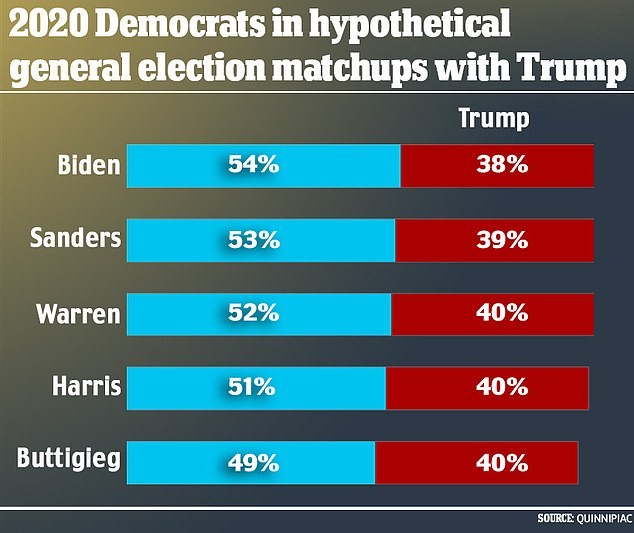Five Democratic primary candidates could beat Donald Trump if a general election were held today, the worst poll yet for the incumbent president.
A new non-partisan Quinnipiac poll has plenty of bad news for Trump — from his 2020 matchups with Democrats, to his own personal image, to his biggest asset in the 2020 race: the economy.
In the hypothetical one-on-one matchups with the president, front-runner Joe Biden had the most likely chance of emerging victorious.
Of the registered voters who responded to the poll, 54 percent said they would vote for the former vice president over the 38 percent who said they would vote for Trump.
Falling easily outside of the 3.1 percent margin of error, respondents also said they would vote for Bernie Sanders, Elizabeth Warren, Kamala Harris and Pete Buttigieg over Trump.
Sanders came in second to beating Trump, earned just one percent less than Biden with 53 per cent to Trump’s 39.
Warren beat Trump 52-40 percent, Harris 51-40 percent and Buttigieg 49-40 percent.
The poll also shows his approval/disapproval declining to 38/56, with just 27 percent approving of him strongly and 50 percent disapproving strongly.
He earns the approval of just 32 percent of independents and the disapproval of 60 percent.
In every matchup with a Democrat, he trails among independents by at least 18 points.
This is a demographic that he won in 2016 by four points.
The bad news extends, perhaps most significantly, to the economy.
While six in 10 registered voters still regard the economy as “excellent” (18 percent) or “good” (43 percent), for the first time since June 2016 more Americans say the economy is getting “worse” (37 percent) than say it’s getting “better” (31 percent).
As recently as one year ago, more than twice as many people thought the economy was getting better as thought it was getting worse.
The poll also shows, for the first time, slightly more Americans say Trump’s policies are “hurting” the economy (41 percent) than say they are “helping” (37 percent).
That’s the worst those splits have been in Quinnipiac polling since February 2018.
Despite the polling data, Trump continues to tout his approval ratings, especially within the GOP.
On Tuesday he posted a tweet lauding his 94 percent approval among Republican voters while bashing those challenging him in the 2020 primaries.
Quinnipiac notes that the low numbers could be to Trump’s depleting popularity among white female voters.
In 2016, that voting demographic was key to Trump winning over Hillary Clinton, but today, white women go for the Democratic candidate over the incumbent president by double digits in every presented scenario.
In each of the five matchups, 54-56 percent of white women said they would vote for the Democratic candidate while between 34-40 percent said they would go for Trump.

